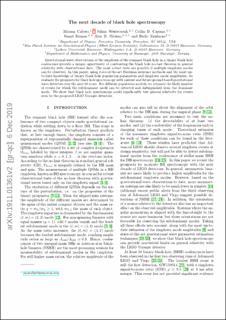| dc.contributor.author | Cabero, Miriam | |
| dc.contributor.author | Westerweck, Julian | |
| dc.contributor.author | Capano, Collin D. | |
| dc.contributor.author | Kumar, Sumit | |
| dc.contributor.author | Nielsen, Alex Bentley | |
| dc.contributor.author | Krishnan, Badri | |
| dc.date.accessioned | 2023-02-09T09:29:39Z | |
| dc.date.available | 2023-02-09T09:29:39Z | |
| dc.date.created | 2020-06-03T12:36:34Z | |
| dc.date.issued | 2020 | |
| dc.identifier.citation | Cabero, M., Westerweck, J., Capano, C. D., Kumar, S., Nielsen, A. B., & Krishnan, B. (2020). Black hole spectroscopy in the next decade. Physical Review D, 101(6), 064044. | en_US |
| dc.identifier.issn | 2470-0010 | |
| dc.identifier.uri | https://hdl.handle.net/11250/3049553 | |
| dc.description.abstract | Gravitational wave observations of the ringdown of the remnant black hole in a binary black hole coalescence provide a unique opportunity of confronting the black hole no-hair theorem in general relativity with observational data. The most robust tests are possible if multiple ringdown modes can be observed. In this paper, using state-of-the-art Bayesian inference methods and the most up-to-date knowledge of binary black hole population parameters and ringdown mode amplitudes, we evaluate the prospects for black hole spectroscopy with current and future ground based gravitational wave detectors over the next 10 years. For different population models, we estimate the likely number of events for which the subdominant mode can be detected and distinguished from the dominant mode. We show that black hole spectroscopy could significantly test general relativity for events seen by the proposed LIGO Voyager detectors. | en_US |
| dc.language.iso | eng | en_US |
| dc.publisher | American Physical Society | en_US |
| dc.title | Black hole spectroscopy in the next decade | en_US |
| dc.type | Peer reviewed | en_US |
| dc.type | Journal article | en_US |
| dc.description.version | acceptedVersion | en_US |
| dc.rights.holder | The authors | en_US |
| dc.subject.nsi | VDP::Matematikk og Naturvitenskap: 400 | en_US |
| dc.source.pagenumber | 7 | en_US |
| dc.source.volume | 101 | en_US |
| dc.source.journal | Physical Review D | en_US |
| dc.source.issue | 6 | en_US |
| dc.identifier.doi | 10.1103/PhysRevD.101.064044 | |
| dc.identifier.cristin | 1813631 | |
| cristin.ispublished | true | |
| cristin.fulltext | postprint | |
| cristin.qualitycode | 1 | |
